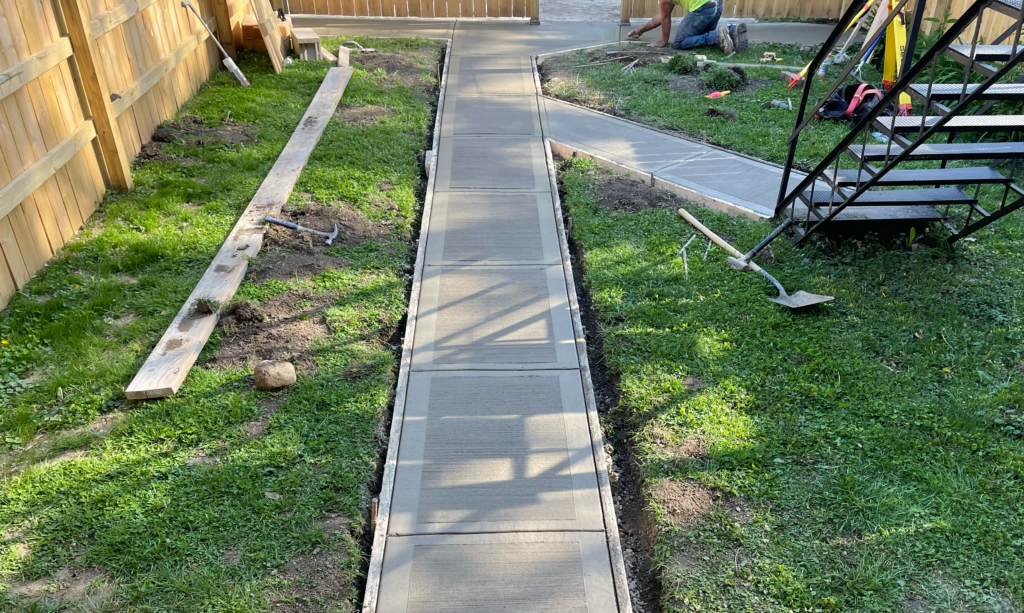Determining the Ideal Thickness for Your Concrete Sidewalk
The standard thickness for a pedestrian-friendly concrete sidewalk is approximately four inches. The primary use of your sidewalk dictates its required thickness. While a four-inch depth suffices for foot traffic and lightweight wheeled devices like bicycles and pushcarts, sidewalks for motor vehicles or those intersecting driveways necessitate a greater thickness, potentially up to 8 inches.

Ensuring the Longevity of Your Sidewalk
The depth of your concrete pathway plays a pivotal role in its aesthetics and durability. Correct installation is paramount to achieve a sidewalk that not only looks professional but also stands the test of time. A well-executed sidewalk installation should cater to your requirements without incurring unnecessary expenses.
The Rebar Debate: Is It Necessary for Sidewalks?
Contrary to popular belief, most sidewalks don’t require rebar reinforcement. A rebar, short for reinforcement bar, is a steel bar employed to bolster concrete’s capacity to bear substantial weight. It’s commonly integrated into sidewalks designed to support heavy-duty vehicles or machinery. However, for general-purpose sidewalks, rebar might be an overkill. Moreover, rebar can make future sidewalk repairs more challenging and costly.
Understanding the Role of Expansion Joints
You might have noticed lines on sidewalks that resemble cracks. These are expansion joints strategically placed to accommodate concrete’s natural expansion and contraction due to temperature and moisture fluctuations. These joints mitigate the risk of unsightly and hazardous random cracks. There are primarily two types of joints:
Control Joints: Visible on most sidewalks, these joints are approximately a quarter deep of the sidewalk’s thickness and are 8-12 feet apart. They can be formed during the concrete pouring or cut post-pouring.
Expansion Joints: These are essential where a sidewalk meets another structure or material, like buildings or other pathways. They span the entire depth of the sidewalk and are positioned before pouring the concrete.
Preserve Your Sidewalk with Sealing
To enhance your sidewalk’s lifespan, consider sealing it. Sealing wards off accumulated stains and protects against weathering. Ideally, seal your sidewalk shortly after it’s laid and reapply the sealant periodically. After about a month of curing, your sidewalk will be ready for sealing, but it’s advisable to consult your paving company for the best timing.
What to Expect from a Professional Sidewalk Installation
If you’re considering a commercial sidewalk installation, it’s essential to know the process:
Old Sidewalk Removal: If your sidewalk is beyond repair, professionals will have the necessary equipment to dismantle and recycle it.
Cost Estimation: The price largely depends on the sidewalk’s size, but other factors like preparatory work, design intricacies, and old sidewalk removal also play a role.
Installation Duration: Most projects span 1-3 days, with additional time for finishing touches like sealants.
Sidewalk Usage Guidelines: While a new sidewalk requires about 28 days to cure fully, light foot traffic can resume after three days. However, avoid heavy weights or sharp objects for the initial days.
A well-installed concrete sidewalk is a long-term asset. If you’re contemplating a new sidewalk for your residential or commercial space, Concrete Dreams of Central Ohio is here to deliver impeccable results. Our team is committed to excellence in service, craftsmanship, and material quality. Explore our blog for a deeper dive into pavement intricacies.




